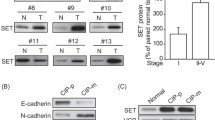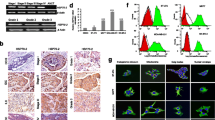Abstract
B-cell lymphoma 2 (Bcl-2) and heat shock protein (HSP) families are implicated in various processes of carcinogenesis, owing to their role in regulation of apoptosis and cell cycle, respectively. mRNA expression of Bcl-2, myeloid cell leukemia 1 (Mcl-1), B-cell lymphoma-extra-large (Bcl-xl), Bcl2-associated X (Bax), HSP70 and HSP90-β genes were studied in 30 clinical canine mammary tumors (CMTs). Histological ‘type’ and ‘grade’ were assigned to CMTs and expression was evaluated by SYBR-Green real-time PCR assay. Overall, the tumors exhibited the maximum expression of Bcl-2 amongst the Bcl-2 family members. Sarcoma and carcinosarcoma showed relatively higher expression of Mcl-1, whereas Bcl-2 was over-expressed in carcinoma. In relation to the cancer grades, Bcl-2/Bax ratio tend to increase as the tumor differentiation progressed from well to poorly differentiated. HSP90-β exhibited significantly high expression in carcinoma, carcinosarcoma and all grades of CMTs were suggestive of their elemental role in tumor progression. In conclusion, this study underpins the conjecture that Bcl-2, Mcl-1 and HSP90-β can be used as potential targets of inhibition in future mammary tumor therapeutics.
Similar content being viewed by others
Abbreviations
- Bax:
-
Bcl2-associated X
- Bcl-2:
-
B-cell lymphoma 2
- Bcl-xl:
-
B-cell lymphoma-extra-large
- CMT:
-
canine mammary tumor
- Ct:
-
cycle threshold
- HSP:
-
heat-shock protein
- Mcl-1:
-
myeloid cell leukemia 1
- OM:
-
original magnification
References
Blagosklonny M.V. 2001. Re: Role of the heat shock response and molecular chaperones in oncogenesis and cell death. J. Natl. Cancer Inst. 93 239–240.
Bostock D.E. 1975. The prognosis following the surgical excision of canine malignant mammary neoplasia. Eur. J. Cancer 11 389–390.
Bostock D.E., Moriarty J. & Crocker J. 1992. Correlation between histologic diagnosis mean nucleolar organizer region count and prognosis in canine mammary tumors. Vet. Pathol. 29 381–385.
Bukau B., Weissman J. & Horwich A. 2006. Molecular chaperones and protein quality control. Cell 125 443–451.
Calderwood S.K. 2010. Heat shock proteins in breast cancer progression–a suitable case for treatment. Int. J. Hyperthermia 26 681–685.
Ciocca D.R., Clark G.M., Tandon A.K., Fuqua S.A., Welch W.J. & McGuire W.L. 1993. Heat shock protein Hsp70 in patients with axillary lymph node-negative breast cancer: prognostic implications. J. Natl. Cancer Inst. 85 570–574.
Ciocca D.R., Rozados V.R., Cuello-Carrion F.D., Gervasoni S.I., Matar P. & Scharovsky O.G. 2003. Heat shock proteins 25 and 70 in rodent tumors treated with doxorubicin and lovastatin. Cell Stress Chaperones 8 26–36.
Cornford P.A., Dodson A.R. & Parsons K.F. 2000. Heat shock protein expression independently predicts clinical outcome in prostate cancer. Cancer Res. 60 7099–7105.
Ellis I.O., Schmitt S.J. & Sastre-Garau X. 2003. Invasive breast carcinoma, pp. 13–59. In: Tavassoli F.A. & Deville P. (eds). World Health Organization Classification of Tumors: Pathology and Genetics. Tumors of the Breast and Female Genital Organs, IARC Press, Lyon.
Elston C.W. & Ellis I.O. 1991. Pathological prognostic factors in breast cancer–the value of histological grade in breast cancer: experience from a large study with long-term followup. Histopathology 19 403–410.
Fidler I.J. & Brodey R.S. 1967. The biological behavior of canine mammary neoplasms. J. Am. Vet. Med. Assoc. 151 1311–1318.
Gabai V.L., Meriin A.B., Yaglom J.A., Volloch V.Z. & Sherman M.Y. 1998. Role of Hsp70 in regulation of stress-kinase JNK: implications in apoptosis and aging. FEBS Lett. 438 1–4.
Garrido C., Brunet M., Didelot C., Zermati Y., Schmitt E. & Kroemer G. 2006. Heat shock proteins 27 and 70: antiapoptotic proteins with tumorigenic properties. Cell Cycle 5 2592–2601.
Gilbertson S.R., Kurzman I.D., Zachrau R.E., Hurvitz A.I. & Black M.M. 1983. Canine mammary epithelial neoplasms: biologic implications of morphologic characteristics assessed in 232 dogs. Vet. Pathol. 20 127–142.
Goldschmidt M., Pena L., Rasotto R. & Zappulli V. 2011. Classification and grading of canine mammary tumors. Vet. Pathol. 48 117–131.
Hellmen E., Bergstrom R., Holmberg L., Spangberg I.B., Hansson K. & Lindgren A. 1993. Prognostic factors in canine mammary tumors: a multivariate study of 202 consecutive cases. Vet. Pathol. 30 20–27.
Jones E.L., Zhao M.J., Stevenson M.A. & Calderwood S.K. 2004. The 70 kilodalton heat shock protein is an inhibitor of apoptosis in prostate cancer. Int. J. Hyperthermia 20 835–849.
Kano R., Yano T., Nagamatsu K., Maruyama H., Kamata H. & Hasegawa A. 2009. Effectiveness of small interfering RNA (siRNA) against the Mcl-1 gene in a canine mammary gland tumor cell line. Res. Vet. Sci. 87 64–66.
Kerr J.F., Wyllie A.H. & Currie A.R. 1972. Apoptosis: a basic biological phenomenon with wide-ranging implications in tissue kinetics. Br. J. Cancer 26 239–257.
Kirkin V., Joos S. & Zornig M. 2004. The role of Bcl-2 family members in tumorigenesis. Biochim. Biophys. Acta 1644 229–249.
Krajewski S., Krajewska M. & Turner B.C. 1999. Prognostic significance of apoptosis regulators in breast cancer. Endocr. Relat. Cancer 6 29–40.
Lana S.E., Rutteman G.R., MacEwen E.G. & Withrow S.J. 2007. Tumors of the mammary gland, pp. 619–636. In: Withrow S.J. & MacEwen E.G. (eds. Small Animal Clinical Oncology. 4th Edn., Saunders, Philadelphia.
Lilling G., Hacohen H. & Nordenberg J. 2000. Differential sensitivity of MCF-7 and LCC2 cells to multiple growth inhibitory agents: possible relation to high bcl-2 /bax ratio. Cancer Lett. 161 27–34.
Lindquist S. & Craig E.A. 1988. The heat shock proteins. Annu. Rev. Genet. 22 631–637.
Lipponen P. 1999. Apoptosis in breast cancer: relationship with other pathological parameters. Endocr. Relat. Cancer 6 13–16.
Lohr C.V., Teifke J.P., Failing K. & Weiss E. 1997. Characterization of the proliferation state in canine mammary tumors by the standardized AgNOR method with postfixation and immunohistologic detection of Ki-67 and PCNA. Vet. Pathol. 34 212–221.
Lowe S.W. & Lin A.W. 2000. Apoptosis in cancer. Carcinogenesis 21 485–495.
Luna L.G. 1968. Manual of Histological Staining Methods of the Armed Forces Institute of Pathology. 3th Edn., McGraw Hill, New York, 258 pp.
Misdorp W., Else R.W., Hellmen E. & Lipscomb T.P. 1999. Histological classi?cation of mammary tumors of the dog and the cat. Second Series, Volume V.I. WHO, Armed Forces Institute of Pathology, American Registry of Pathology, Washington, D.C.
Mitra N., Verma R., Pawar H.N., Deka D., Agrawal R. & Singh A. 2014. Cloning, sequence analysis and structure prediction of B cell lymphoma-2 of Canis familiaris. Int. J. Curr. Microbiol. App. Sci. 3 370–382.
Nylandsted J., Rohde M., Brand K., Bastholm L., Elling F. & Jaattela M. 2000. Selective depletion of heat shock protein 70 (Hsp70) activates a tumor-specific death program that is independent of caspases and bypasses Bcl-2. Proc Natl. Acad. Sci. USA 97 7871–7876.
Oltvai Z.N., Milliman C.L. & Korsmeyer S.J. 1993. Bcl-2 heterodimerizes in vivo with a conserved homolog, Bax, that accelerates programmed cell death. Cell 74 609–619.
Owen L.N. 1979. A comparative study of canine and human breast cancer. Invest. Cell Pathol. 2 257–275.
Pang L.Y., Cervantes-Arias A., Else R.W. & Argyle D.J. 2011. Canine mammary cancer stem cells are radio- and chemoresistant and exhibit an epithelial-mesenchymal transition phenotype. Cancers (Basel) 3 1744–1762.
Pawar H.N., Brah G.S., Agrawal R.K. & Ramneek. 2012. Differential expression kinetics of heat shock protein 70 and associated cytokines between cattle and Buffalo species. J. Cell Tissue Res. 12 3173–3179.
Perez Alenza M.D., Pena L., del Castillo N. & Nieto A.I. 2000. Factors influencing the incidence and prognosis of canine mammary tumors. J. Small Anim. Pract. 41 287–291.
Petros A.M., Olejniczak E.T. & Fesik S.W. 2004. Structural biology of the Bcl-2 family of proteins. Biochim. Biophys. Acta 1644 83–94.
Poltronieri C., Maccatrozzo L., Simontacchi C., Bertotto D., Funkenstein B., Patruno M. & Radaelli G. 2007. Quantitative RT-PCR analysis and immunohistochemical localization of HSP70 in sea bass Dicentrarchus labrax exposed to transport stress. Eur. J. Histochem. 51 125–136.
Rong B., Zhao C., Liu H., Ming Z., Cai X., Gao W. & Yang S. 2014. Identification and verification of Hsp90-β as a potential serum biomarker for lung cancer. Am. J. Cancer Res. 4 874–885.
Sonnenschein E.G., Glickman L.T., Goldschmidit M.H. & McKee L.J. 1991. Body conformation, diet and risk of breast cancer in pet dogs: a case control study. Am. J. Epidemiol. 133 694–703.
Sorenmo K. 2003. Canine mammary gland tumors. Vet. Clin. North Am. Small Anim. Pract. 33 573–596.
Thanner F., Sutterlin M.W., Kapp M., Rieger L., Kristen P., Dietl J., Gassel A.M. & Muller T. 2003. Heat-shock protein 70 as a prognostic marker in node-negative breast cancer. Anticancer Res. 23 1057–1062.
Volloch V.Z. & Sherman M.Y. 1999. Oncogenic potential of Hsp72. Oncogene 18 3648–3651.
Whitesell L. & Lindquist S.L. 2005. HSP90 and the chaperoning of cancer. Nat. Rev. Cancer 5 761–772.
Yamagami T., Kobayashi T., Takahashi K. & Sugiyama M. 1996. Prognosis for canine malignant mammary tumors based on TNM and histologic classification. J. Vet. Med. Sci. 58 1079–1083.
Yano M., Naito Z., Tanaka S. & Asano G. 1996. Expression and roles of heat shock proteins in human breast cancer. Jpn. J. Cancer Res. 87 908–915.
Acknowledgements
The authors are grateful to the Director, School of Animal Biotechnology, Dean, Post Graduate Studies and Director of Research, Guru Angad Dev Veterinary and Animal Sciences University, Ludhiana (Punjab), India, for providing funds and necessary infrastructural facilities to carry out this study.
Author information
Authors and Affiliations
Corresponding author
Rights and permissions
About this article
Cite this article
Mitra, N., Verma, R., Deka, D. et al. Differential expression of apoptosis-associated genes in canine mammary tumors. Biologia 70, 846–852 (2015). https://doi.org/10.1515/biolog-2015-0094
Received:
Accepted:
Published:
Issue Date:
DOI: https://doi.org/10.1515/biolog-2015-0094




